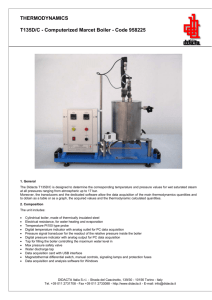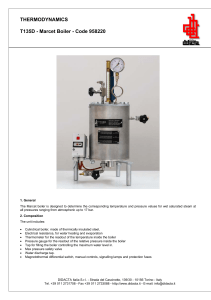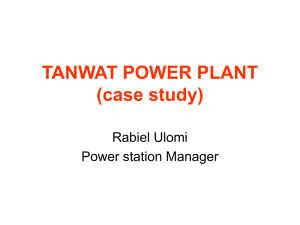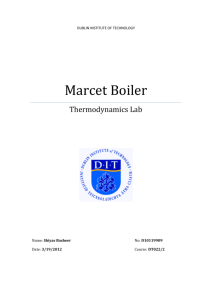When is Reverse Osmosis Right for Boiler Pre
advertisement
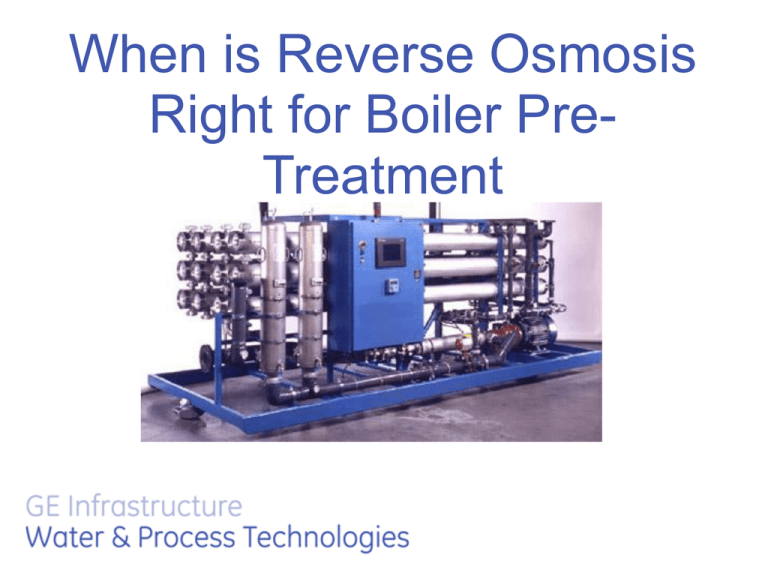
When is Reverse Osmosis Right for Boiler PreTreatment RO Benefits • • • • • • • • Reduced fuel costs through lower heat loss / increased boiler cycles Reduced boiler system chemical treatment costs Improved operation & Steam Purity Reduced risk Improved condensate corrosion control Reduced external treatment costs; particularly if previously using cold or hot lime softening, ion exchange and / or re-generable DI Remove / reduce hazardous acid and caustic chemicals Extended ion exchange resin life What to consider when looking at RO for boiler pretreatment • Cycles of concentration Size of plant – steam production FW Quality • Make-up alkalinity, Dissolved mineral breakdown % FW make up - % hot condensate return • • - • • • • Pressure deaerator or FW tank? Feed water piping and pump construction Is there a use for RO reject (cooling tower MU) Chemical Program types - Separates, all-in-ones, powders, liquids, etc. Questions to help you qualify feasibility of replacing demins with RO/EDI 1. Is the customer concerned with handling acid and caustic? 2. What is the conductivity of the influent water? The higher the dissolved solids in the influent water, the greater the potential benefits. 3. How much acid and caustic are used and what is the cost? 4. What is the cost of power? 5. Can the plant effectively use the RO reject water? Or will the increase in water consumption and waste volume be an issue? 6. Is this a new installation or is the customer considering replacement of or renovating an existing demineralizer system? ASME GUIDELINES Table 1 - Watertube Boiler with Superheater/Turbine All Pressures: FW dissolved oxygen < 7 ppb (with DA) Feedwater pH: 8.3 - 10.0 (0- 900 psig) / pH 8.8 - 9.6 (> 901 psig) Boiler Feedwater Drum Pressure (psig) 0 to 300 300 to 450 451 to 600 601 to 750 751 to 900 901 to 1,000 1,001 to 1,500 1,501 to 2,000 Iron (ppm Fe) 0.100 0.050 0.030 0.025 0.020 0.020 0.010 0.010 Boiler Water Total Hardness Copper ppm (ppm Cu) CaCO 3 ( 0.050 0.025 0.020 0.020 0.015 0.015 0.010 0.010 Silica ppm SiO 2 )( 0.300 0.300 0.200 0.200 0.100 0.050 0.000 0.000 150 90 40 30 20 8 2 1 Total alkalinity ppm CaCO 3 )( ) 350 300 250 200 150 100 - Specific Conductance (mhos/cm) (Unneutralized) 3500 3000 2500 2000 1500 1000 150 100 Note: All limits are expressed “less than” the value specified (e.g., < 0.100 ppm) Impact of feedwater quality on boiler operational efficiency Fuel-to-steam efficiency o Fuel is 70 – 80% of boiler operating costs Fuel o Water & Sewer costs 3 – 5% o But - Feedwater quality has enormous impact on boiler efficiency & fuel costs Water & Sewer Reliability and availability o Industry statistics – Tube failures due to waterside mechanisms are the leading cause of unscheduled Boiler outages Impact of feedwater quality on boiler operational efficiency Steam purity o Steam purity is a direct function of boiler water dissolved solids content o Superheater and turbine reliability o High-purity processes Semiconductors Pharmaceuticals Catalytic hydrocarbon / chemical processes Food and beverage processing/sterilization Comfort humidification Medical and research steam sterilization processes Boiler feedwater quality considerations Boiler pressure and superheater/turbine steam purity requirements generally define pretreatment and feedwater quality requirements. In general – > Softened or single pass RO-quality make-up < 600 psig > Generally demineralized or RO/EDI make-up > 900 psi Resin Based Pretreatment Performance Syste m Softener Dealkalizer Standard two-bed demineralizer Typical Effluent Quality Typical Boiler Operating Pressure (psig) 0.2-1.0 ppm hardness 0 to 600 (no TDS reduction) 50 to 90% alkalinity 0 to 600 reduction (no TDS reduction) 400 to 900 <10 mho <200 ppb silica Two-bed demineralizer with <5 mho counterflow regeneration <50 ppb silica 900 to 1,200 Two-bed demineralizer with <0.1 mho mixed bed polisher <10 ppb silica 1,200+ Benefits for the Customer Conversion from Softened to RO Makeup • Improved steam purity & safety — Improved purity of products/processes contacted by steam — Reduced steam contamination — Enhanced regulatory compliance • Improved steam equipment reliability, efficiency & longevity — Improved safety - Reduced chance of catastrophic failure — Improved turbine efficiency — Improved steam heat transfer efficiency • Reduced total cost of operation (must qualify carefully) — — — — Improved steam system heat transfer efficiency Improved boiler thermal efficiency Reduced chemical treatment costs Reduced regenerant costs Questions to help you qualify feasibility of pursuing RO conversions from NaZ 1. RO will generally reduce our overall boiler chemical revenue by a factor of 60-80% . Is customer looking to reduce chemical? 2. Is there a significant operational or efficiency issue that can be solved by higher purity FW? 3. Does the plant lack blowdown heat recovery equipment (or is it inoperable)? 4. Is there competitive pressure or a bid that is compelling you to consider RO as a solution? 5. Are current average cycles of concentration < 10? Technical considerations in conversions from Na Zeolite to Reverse Osmosis Makeup • RO permeate carbon dioxide considerations & reduction strategies — Corrosivity of RO permeate — Alloy considerations — Preferred methods of pH adjustment • • • • Consider boiler feed pump alloys Selection of oxygen scavenger Internal treatment program considerations Condensate corrosion discussion & pH control range Zeolite Softening & Dealkalization Advantages • Inexpensive – Capital & operating costs • Simple-to-operate • Durable • Safe & inexpensive sodium chloride regenerant Limitations •No reduction in total dissolved solids (TDS) • FW quality can limit boiler cycles • Not suitable for high-pressure boiler operation (> 900 psig) • No silica reduction • No alkalinity reduction without dealkalizer Resin-based demineralization Advantages • Reduction in all dissolved solids • Enables high cycles operation • Suitable for high-pressure boilers • Can tailor to specific purity needs • Excellent silica rejection • Excellent alkalinity/CO2 rejection Limitations • Strong acid/caustic required for regeneration • Caustic costs high & variable • Limited anion resin life • Silica and sodium leakage • Manpower intensive • Operating costs directly proportional to TDS Reverse Osmosis Advantages Limitations • Rejection of all dissolved solids • Operating costs not directly dependant on TDS • Enables high cycle boiler operation • Requires no chemical regenerants (acid/caustic) • Not labor intensive • Versatile pairings with resin-based systems • Ideal for mobile applications • RO alone not suitable for HP boiler feedwater > 1000 psig with turbine • Higher electrical costs than resinbased systems (high-pressure pumps) • Generates significant reject stream (typically 20 – 30% of input stream) • Does not reject CO2 (g) Potential membrane solutions for Boiler systems 1. RO in front of existing demineralizers 2. RO to replace or augment softeners 3. RO/EDI to replace resin-based demineralizer - Mixed-bed quality train 4. Ultrafiltration in front of demin. or RO to replace traditional filtration/clarification Key input variables for modeling & analysis Economic TDS of influent water Capital equipment costs (RO) Caustic costs Electrical power rates Influent water costs Sewerage costs Environmental Reduction of acid/caustic inventory Personnel safety - chemical exposure Water scarcity issues Discharge/permitting issues o Volume or Vol/TDS-basis? o Can plant reuse RO reject? o Credits or incentives for reuse Regenerant neutralization costs Differential labor costs This can be a critical factor because direct sewerage of the RO reject stream may be costly Case 1 - Potential Benefits in the Addition of RO ahead of Demineralizer •Reduced acid & caustic regenerant costs – 90 – 95% reduction in regenerant usage is typical •Reduced operator labor •Reduced high TDS regenerant neutralization discharge •Extended ion exchange resin life – 40 – 50% extension in resin life typical – Greatly reduced regen. cycles & reduced iron/organic fouling •Improved feedwater & steam quality – Sodium & silica slippage & breaks significantly reduced RO Preceding Demineralizer Example with relatively inexpensive water and sewerage RO cost justified above approx. 200 ppm TDS RO to preceed Demin. $0.50/kgal raw water / $0.50/kgal waste 3 Demin. $/kgal 2.5 2 RO wdegas,neutr 1.5 Linear (wdegas,neutr) 1 0.5 0 100 312 TDS, ppm 473 Capital and operating cost of RO included RO Preceding Demineralizer Example with more expensive water and sewerage RO cost justified above approx. 400 ppm TDS RO value to precede demin, $1.50/kgal raw water, $2.00/kgal waste 5 4.5 4 RO $/kgal 3.5 3 2.5 wdegas,neutr Linear (wdegas,neutr) 2 1.5 Capital and operating cost of RO included 1 0.5 0 100 312 TDS, ppm 473 Case 1 Summary - RO in front of Demineralizer Annual cost savings based on water production and savings per 1000 gallons $600,000 Annual Savings $500,000 $400,000 $0.50 $300,000 $0.75 $1.00 $200,000 $100,000 $0 100 250 500 Flowrate GPM (24/7/365 basis) 1000 Case 2 - Potential Benefits Conversion from Softened to RO make-up • Improved steam purity > Process/Turbine • Improved condensate corrosion control > High-alkalinity waters • Minimizes operating and maintenance expenses > Boiler waterside and steamside failures • Maintains optimal thermal performance > Boiler and steam heat transfer efficiency • Reduced chemical treatment costs > Higher cycles operation – less wastage > Lower steam system treatment requirements Typical Problems encountered in Softened water boiler systems Steam purity issues Condensate Corrosion A look at fuel and water savings when increasing boiler cycles noting a natural cost of $8 per decatherm. Potential Energy Loss Versus Waterside Scale Thickness Energy Loss (%) Iron & Silica High Iron Content 7 6 5 4 3 2 1 0 "Normal" Scale 1/64 1/32 3/64 Scale Thickness (Inches) 1/16 Saving Water & Energy is a Big Win in Every Way, and the creative use of Membrane solutions for Boilers can help you to make it happen at your facility!
